
Pigneau de Behaine
Encyclopedia
Pierre Joseph Georges Pigneau (2 November 1741 Origny-en-Thiérache
– 9 October 1799, Qui Nhơn
), commonly known as Pigneau de Béhaine, also Pierre Pigneaux and Bá Đa Lộc (百多祿 or 伯多祿), was a French Catholic
priest
best known for his role in assisting Nguyễn Ánh (later Emperor Gia Long
) to establish the Nguyễn Dynasty in Vietnam
after the Tây Sơn rebellion
.
(later Aisne
, France), where the family of his mother lived. His father's family owned a small estate named Béhaine, in the nearby commune
of Marle
. Despite the particule "de Béhaine" in his name, Pigneau was not of noble extraction, and it seems the particule first appeared only in the 1787 Treaty of Versailles
.
Pigneau de Behaine was trained as a missionary
and sent abroad by the Paris Foreign Missions Society
(Séminaire des Missions Étrangères). He left France from the harbour of Lorient
in December 1765, to work in southern Vietnam. He landed in Pondicherry, then a French possession in India, on 21 June 1766.
Pigneau had arrived just prior to the Burmese
capture of Ayutthaya
in Siam
. After waiting for a few months in the Portuguese colony of Macau
, Pigneau travelled on a Chinese ship to reach the small coastal town Ha Tien
in Cochinchina
(Southern Vietnam
) near the Cambodian border, set up by missionaries who had been displaced by the Burmese. He arrived there in March 1767.
in Siam following the 1765 Burmese invasion, with approximately forty students of Chinese
, Siamese
, and Vietnamese
extraction.
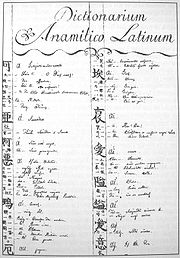 In 1768, the missionaries were jailed for three months when Siamese authorities complained to the local ruler Mạc Thiên Tứ that the school had afforded shelter to a fugitive Siamese prince. Pigneau was put into a cangue
In 1768, the missionaries were jailed for three months when Siamese authorities complained to the local ruler Mạc Thiên Tứ that the school had afforded shelter to a fugitive Siamese prince. Pigneau was put into a cangue
, a wooden and iron frame fastened around his limbs weighing eight pounds. He ignored family requests to return to France, saying that his missionary work was more important than a comfortable life. In 1769, the school was attacked by Chinese and Cambodia
n pirates, who massacred some of the students and burnt down the establishment... Pigneau was forced to flee in December 1769 with the survivors to Pondicherry (now in Tamil Nadu
, India), then a French territory, after a long sea journey through Malacca
. The College was established a few miles from Pondicherry, in Virampatnam.
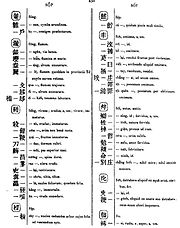 While in Pondicherry, Pigneau continued mastering Chinese and Vietnamese languages until he was fully conversant with both. In 1773, he compiled a Vietnamese-Latin dictionary with the help of eight southern Vietnamese, following in the footsteps of Alexandre de Rhodes. His work, Dictionarium Anamitico-Latinum, would be published in 1838 by Mgr Jean-Louis Taberd
While in Pondicherry, Pigneau continued mastering Chinese and Vietnamese languages until he was fully conversant with both. In 1773, he compiled a Vietnamese-Latin dictionary with the help of eight southern Vietnamese, following in the footsteps of Alexandre de Rhodes. His work, Dictionarium Anamitico-Latinum, would be published in 1838 by Mgr Jean-Louis Taberd
.
Pigneau de Behaine was made Bishop of Adran (of Adranos in Bithynia
, modern Orhaneli
in Turkey
, in partibus infidelium), and Apostolic Vicar of Cochinchina
on 24 February 1774 in São Tomé near Madras. After his ordination in 1774, he went to Macau
to gather more staff before returning to resume his work in Ha Tien. In Macau, he was able to publish and print a catechism
in Vietnamese)(containing an introduction in Chinese, the body of the text in the Vietnamese alphabet
, and a translation in Latin
), and despatched a copy to Rome. He left Macau on 1 March 1775, and reached Ha Tien later in the month, where he again re-established missionary operations.
In 1775-76, Pigneau attempted to convert the Stieng people
, but the missionaries he sent suffered greatly, and either fell ill or returned.
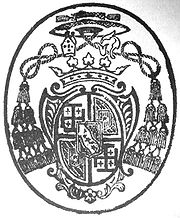 In 1777, the Tây Sơn brothers attacked Saigon and eliminated almost the entire Nguyễn Dynasty, with the fifteen-year-old Nguyễn Ánh managing to escape into the far south. He took refuge at Pigneau's seminary from September to October before both were forced to flee to the island of Pulo Panjang in the Gulf of Siam. The move was a political step taken by Pigneau to align himself with Nguyễn Ánh, allowing himself a foray into politics. He became less of a missionary and more of a politician thereafter.
In 1777, the Tây Sơn brothers attacked Saigon and eliminated almost the entire Nguyễn Dynasty, with the fifteen-year-old Nguyễn Ánh managing to escape into the far south. He took refuge at Pigneau's seminary from September to October before both were forced to flee to the island of Pulo Panjang in the Gulf of Siam. The move was a political step taken by Pigneau to align himself with Nguyễn Ánh, allowing himself a foray into politics. He became less of a missionary and more of a politician thereafter.
On November 1777, Nguyễn Ánh was able to recapture Saigon, and in 1778 pursued the retreating Tây Sơn as far as Binh Thuan.
In neighbouring Cambodia
, a pro-Cochinchinese revolt erupted to topple the pro-Siam king Ang Non. In 1780, Cochinchinese troops intervened, and Pigneau helped them procure weapons from the Portuguese. The Bishop attracted accusations by the Portuguese of manufacturing weapons for the Cochinchinese, especially grenade
s, a new weapon for Southeast Asia. Pigneau de Behaine also organized the supply of three Portuguese warships for Nguyễn Ánh. In his activities, Pigneau was supported by a French adventurer, Manuel.
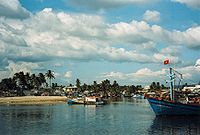 In 1782, the Tây Sơn led a new offensive to the South. Manuel died in his command of a warship in the Saigon river against Tây Sơn troops. The defeat, with its battle plan deemed faulty, towers high in the list of setbacks suffered. Nguyễn Ánh was forced to retreat to the island of Phu Quoc. In October 1782, the tide turned again and Nguyễn Ánh and Pigneau returned to Saigon.
In 1782, the Tây Sơn led a new offensive to the South. Manuel died in his command of a warship in the Saigon river against Tây Sơn troops. The defeat, with its battle plan deemed faulty, towers high in the list of setbacks suffered. Nguyễn Ánh was forced to retreat to the island of Phu Quoc. In October 1782, the tide turned again and Nguyễn Ánh and Pigneau returned to Saigon.
In March 1783, the Nguyễn were again defeated, and Nguyễn Ánh and Pigneau once more set sail for Phu Quoc. Sanctuary was at once both fleeting and illusory. They had to escape again when their hideout was discovered, being chased from island to island until they reached Siam. Pigneau de Behaine visited the Siamese court in Bangkok
in late 1783. Nguyễn Ánh also arrived there in February 1784, where he enlisted an army to accompany him back to Vietnam. In January 1785 however the Siamese fleet met with disaster against the Tây Sơn in the Mekong river.
Nguyễn Ánh again took refuge with the Siamese court, and again tried to seek help from the Siamese. Resolving to muster any support he could from Western powers., Nguyễn Ánh asked Pigneau to appeal for French aid, and pledged to allow Pigneau to take his son Prince Cảnh with him. Pigneau in return attempted to obtain assistance from Manila
, but the party of Dominicans he sent was captured by the Tây Sơn. From Pondicherry, he also sent a request for help to the Portuguese Senate in Macao
, which would ultimately lead to the signature of a Treaty of Alliance between Nguyễn Ánh and the Portuguese on 18 December 1786 in Bangkok.
, seconded by Captain d'Entrecasteaux
, was resolutely opposed to intervening in southern Vietnam, stating that it was not in the national interest. In July 1786, Pigneau was allowed to travel back to France to ask the royal court directly for assistance. News of his activities reached Rome where he was denounced by the Spanish Franciscans. Pigneau at that point offered Prince Cảnh and his political mandate to the Portuguese. They left Pondicherry for France in July 1786. which they reached in February 1787.
 Arriving in February 1787 with the child prince Canh at the court of Louis XVI
Arriving in February 1787 with the child prince Canh at the court of Louis XVI
in Versailles
, Pigneau had difficulty in gathering support for a French expedition to install Nguyễn Ánh on the throne. This was due to the poor financial state of the country prior to the French Revolution
. Pigneau was helped by Pierre Poivre
who had been involved previously in French interests in Vietnam.
Eventually, he was able to seduce military figures with precise instructions as to the conditions of warfare in Indochina and materiel for the proposed campaign. He explained how France would be able to "dominate the seas of China and of the archipelago." The party met with King Louis XVI, Minister of the Navy de Castries
and Minister of Foreign Affairs Montmorin
on May 5 or 6, 1787. Prince Cảnh created a sensation at the court of Louis XVI, leading the famous hairdresser Léonard to create a hairstyle in his honour "au prince de Cochinchine". His portrait was made in France by Maupérin
, and is now on display at the Séminaire des Missions Étrangères in Paris. Prince Cảnh dazzled the Court and even played with the son of Louis XVI, Louis-Joseph, Dauphin of France, who was about the same age.
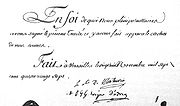 By November, his constant pressure had proved effective. On 21 November 1787, the Treaty of Versailles
By November, his constant pressure had proved effective. On 21 November 1787, the Treaty of Versailles
was concluded between France and Cochinchina in Nguyễn Ánh's name. Four frigates, 1650 fully equipped French soldiers and 250 Indian sepoy
s were promised in return for Pulo Condore and harbour access at Tourane (Da Nang
). De Fresne
was supposed to be the leader of the expedition.
The French government, on the eve of the French Revolution
, was in dreadful financial trouble, and saw its position weakened even more with the outbreak of civil war in Holland. French enthusiasm for Pigneau's plan was severely dampened. A few days after the treaty was signed, the foreign minister sent instructions on 2 December 1787 to the Governor of Pondicherry Thomas Conway
, which left the execution of the treaty to his own appreciation of the situation in Asia, stating that he was "free not to accomplish the expedition, or to delay it, according to his own opinion" Louis XVI himself told Pigneau that Conway was appointed Governor of Pondicherry simply to remove him from Europe.
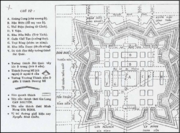
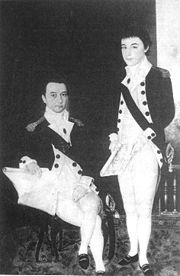 The party left France in December 1787 on board the Dryade, commanded by M. de Kersaint and accompanied by the Pandour, commanded by M. de Préville. They would again disembark in Pondicherry from May 1788 to July 1789. The Dryade was ordered by Conway to continue to Poulo Condor to meet with Nguyễn Ánh and deliver him 1,000 muskets bought in France and Father Paul Nghi, a Cochinchinese missionary devotee of Mgr Pigneau.
The party left France in December 1787 on board the Dryade, commanded by M. de Kersaint and accompanied by the Pandour, commanded by M. de Préville. They would again disembark in Pondicherry from May 1788 to July 1789. The Dryade was ordered by Conway to continue to Poulo Condor to meet with Nguyễn Ánh and deliver him 1,000 muskets bought in France and Father Paul Nghi, a Cochinchinese missionary devotee of Mgr Pigneau.
However, Pigneau found the governor of Pondicherry unwilling to further fulfill the agreement. Although the Royal Council had already decided in October 1788 to endorse Conway, Pigneau was not informed until April. Pigneau was forced to use funds raised in France and enlist French volunteers. Of this duplicity, he defiantly noted: "I shall make the revolution in Cochinchina alone." He rejected an offer from the English, and raised money from French merchants in the region. Conway finally provided two ships to Pigneau, the Méduse, commanded by François Étienne de Rosily-Mesros
, and another frigate. Pigneau used the raised funds to equip two more ships with weapons and ammunition, which he named the Long ("Dragon"), commanded by Jean-Baptiste Chaigneau
, and the Phụng ("Phoenix"), commanded by Philippe Vannier
, and enticed volunteers and deserters to man the vessels. Jean-Marie Dayot
deserted the Pandour and was put in charge of supplies, transporting weapons and ammunitions on his ship the St. Esprit. Rosily, who had been commanding the Méduse deserted with 120 of his men, and was put in charge of recruitments.
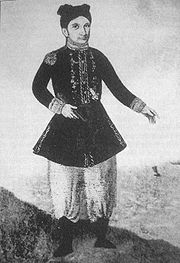 Pigneau's expedition left for Vietnam on June 19, 1789 and arrived at Vung Tau
Pigneau's expedition left for Vietnam on June 19, 1789 and arrived at Vung Tau
on 24 July 1789. The foreign contingent helped to consolidate southern Vietnam and modernized its army, navy and fortifications. Olivier de Puymanel
, a former officer of the Dryade who has deserted in Poulo Condor, built in 1790 the Citadel of Saigon
and in 1793 the Citadel of Dien Khanh
according to the principles of Vauban
. He also instructed Vietnamese troops in the modern use of artillery, and implemented European infantry methods in the Vietnamese army of Nguyễn Phúc Ánh. In 1792, Olivier de Puymanel was commanding an army of 600 men who had been trained with European techniques. Puymanel is said to have trained the 50,000 men of Nguyen's army. French bombs were used at the siege of Qui Nhơn in 1793.
French Navy officers such as Jean-Marie Dayot
and Jean-Baptiste Chaigneau
were used to drill the navy. By 1792, a large naval fleet was formed, with two European warships and 15 frigates of composite design. In 1792, Dayot attacked the strategically important port of Qui Nhơn
, opening the way to the Cochinchinese ships which then defeated the Tây Sơn fleet. In 1793, Dayot led a raid in which 60 Tây Sơn galleys were destroyed.
From 1794, Pigneau took part in all campaigns, accompanying Prince Cảnh. He organized the defense of Dien Khanh
when it was besieged by a numerically vastly superior Tây Sơn army in 1794.
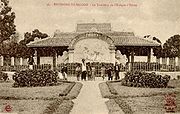 Heavy fighting raged in Qui Nhơn for control of the fortress until it was captured in 1799. Pigneau died there of dysentery
Heavy fighting raged in Qui Nhơn for control of the fortress until it was captured in 1799. Pigneau died there of dysentery
on 9 October in the same year, after serving his final years as an advisor and de facto foreign minister to Nguyễn Ánh. He was buried at Saigon with full military honours. Nguyễn Ánh's funeral oration described him as "the most illustrious foreigner ever to appear at the court of Cochinchina." He was buried on 16 December 1799 in the presence of the crown prince, all mandarins of the court, the royal bodyguard of 12,000 men and 40,000 mourners.
Pigneau de Behaine was the object of several funeral orations on behalf of emperor Gia Long
and his son Prince Cảnh. In a funeral oration dated 8 December 1799, Gia Long praised Pigneau de Behaine's involvement in the defense of the country, as well as their personal friendship:
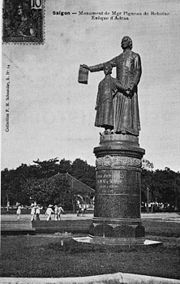 Only a few of Pigneau's men stayed for more than two or three year, disappointed in the lack of a quick fortune. Pigneau himself had wanted a Catholic as ruler of Vietnam. His ambition never materialised with the failure to convert Canh, who predeceased his father Nguyễn Ánh by twenty years in any case.
Only a few of Pigneau's men stayed for more than two or three year, disappointed in the lack of a quick fortune. Pigneau himself had wanted a Catholic as ruler of Vietnam. His ambition never materialised with the failure to convert Canh, who predeceased his father Nguyễn Ánh by twenty years in any case.
Pigneau often compromised his religious principles when they came into conflict with political and diplomatic imperatives. He had initially taught Canh to refuse to engage in ancestor worship, something that greatly shocked and angered Nguyễn Ánh. He later changed his mind on the papal ban and proposed to consider ancestor worship as a civil ceremony, a simple manifestation of respect for the dead. He cited the apostles as being tolerant of local customs as his justification.

 In 1983, the tomb of Pigneau de Behaine was dismantled by the Vietnamese government, and the area was replaced by a park. His remains were incinerated and sent to France, where they are now housed in the Paris Foreign Missions Society
In 1983, the tomb of Pigneau de Behaine was dismantled by the Vietnamese government, and the area was replaced by a park. His remains were incinerated and sent to France, where they are now housed in the Paris Foreign Missions Society
.
Origny-en-Thiérache
Origny-en-Thiérache is a commune in the Aisne department in Picardy in northern France.-Population:-References:*...
– 9 October 1799, Qui Nhơn
Qui Nhon
Qui Nhơn , also Quy Nhơn, is a coastal city in Binh Dinh province in central Vietnam. It is composed of 16 wards and five communes with a total of 286 km². Quy Nhon is the capital of Bình Định province. As of 2009 its population was 280,900. Historically, the commercial activities of the city...
), commonly known as Pigneau de Béhaine, also Pierre Pigneaux and Bá Đa Lộc (百多祿 or 伯多祿), was a French Catholic
Roman Catholic Church
The Catholic Church, also known as the Roman Catholic Church, is the world's largest Christian church, with over a billion members. Led by the Pope, it defines its mission as spreading the gospel of Jesus Christ, administering the sacraments and exercising charity...
priest
Priest
A priest is a person authorized to perform the sacred rites of a religion, especially as a mediatory agent between humans and deities. They also have the authority or power to administer religious rites; in particular, rites of sacrifice to, and propitiation of, a deity or deities...
best known for his role in assisting Nguyễn Ánh (later Emperor Gia Long
Gia Long
Emperor Gia Long , born Nguyễn Phúc Ánh , was an emperor of Vietnam...
) to establish the Nguyễn Dynasty in Vietnam
Vietnam
Vietnam – sometimes spelled Viet Nam , officially the Socialist Republic of Vietnam – is the easternmost country on the Indochina Peninsula in Southeast Asia. It is bordered by China to the north, Laos to the northwest, Cambodia to the southwest, and the South China Sea –...
after the Tây Sơn rebellion
Tây Son Dynasty
The name of Tây Sơn is used in many ways to refer to the period of peasant rebellions and decentralized dynasties established between the eras of the Later Lê and Nguyễn dynasties in the history of Vietnam between 1770 and 1802...
.
Early life
Pigneau was born in Origny-en-ThieracheOrigny-en-Thiérache
Origny-en-Thiérache is a commune in the Aisne department in Picardy in northern France.-Population:-References:*...
(later Aisne
Aisne
Aisne is a department in the northern part of France named after the Aisne River.- History :Aisne is one of the original 83 departments created during the French Revolution on 4 March 1790. It was created from parts of the former provinces of Île-de-France, Picardie, and Champagne.Most of the old...
, France), where the family of his mother lived. His father's family owned a small estate named Béhaine, in the nearby commune
Communes of France
The commune is the lowest level of administrative division in the French Republic. French communes are roughly equivalent to incorporated municipalities or villages in the United States or Gemeinden in Germany...
of Marle
Marle, Aisne
Marle is a commune in the Aisne department in Picardy in northern France.-Population:...
. Despite the particule "de Béhaine" in his name, Pigneau was not of noble extraction, and it seems the particule first appeared only in the 1787 Treaty of Versailles
Treaty of Versailles (1787)
The Versailles Treaty of 1787 was a treaty of alliance signed between the French king Louis XVI and the Vietnamese Prince Nguyễn Ánh, the future Emperor Gia Long....
.
Pigneau de Behaine was trained as a missionary
Missionary
A missionary is a member of a religious group sent into an area to do evangelism or ministries of service, such as education, literacy, social justice, health care and economic development. The word "mission" originates from 1598 when the Jesuits sent members abroad, derived from the Latin...
and sent abroad by the Paris Foreign Missions Society
Paris Foreign Missions Society
The Society of Foreign Missions of Paris is a Roman Catholic missionary organization. It is not a religious order, but an organization of secular priests and lay persons dedicated to missionary work in foreign lands....
(Séminaire des Missions Étrangères). He left France from the harbour of Lorient
Lorient
Lorient, or L'Orient, is a commune and a seaport in the Morbihan department in Brittany in north-western France.-History:At the beginning of the 17th century, merchants who were trading with India had established warehouses in Port-Louis...
in December 1765, to work in southern Vietnam. He landed in Pondicherry, then a French possession in India, on 21 June 1766.
Pigneau had arrived just prior to the Burmese
Myanmar
Burma , officially the Republic of the Union of Myanmar , is a country in Southeast Asia. Burma is bordered by China on the northeast, Laos on the east, Thailand on the southeast, Bangladesh on the west, India on the northwest, the Bay of Bengal to the southwest, and the Andaman Sea on the south....
capture of Ayutthaya
Ayutthaya (city)
Ayutthaya city is the capital of Ayutthaya province in Thailand. Located in the valley of the Chao Phraya River. The city was founded in 1350 by King U Thong, who went there to escape a smallpox outbreak in Lop Buri and proclaimed it the capital of his kingdom, often referred to as the Ayutthaya...
in Siam
Thailand
Thailand , officially the Kingdom of Thailand , formerly known as Siam , is a country located at the centre of the Indochina peninsula and Southeast Asia. It is bordered to the north by Burma and Laos, to the east by Laos and Cambodia, to the south by the Gulf of Thailand and Malaysia, and to the...
. After waiting for a few months in the Portuguese colony of Macau
Macau
Macau , also spelled Macao , is, along with Hong Kong, one of the two special administrative regions of the People's Republic of China...
, Pigneau travelled on a Chinese ship to reach the small coastal town Ha Tien
Hà Tiên
Hà Tiên or Ha Tien is a town in Kien Giang Province, Tay Nam Bo of Vietnam. Area: 8,851.5 ha, population : 39,957. The town borders Cambodia to the west....
in Cochinchina
Cochinchina
Cochinchina is a region encompassing the southern third of Vietnam whose principal city is Saigon. It was a French colony from 1862 to 1954. The later state of South Vietnam was created in 1954 by combining Cochinchina with southern Annam. In Vietnamese, the region is called Nam Bộ...
(Southern Vietnam
Vietnam
Vietnam – sometimes spelled Viet Nam , officially the Socialist Republic of Vietnam – is the easternmost country on the Indochina Peninsula in Southeast Asia. It is bordered by China to the north, Laos to the northwest, Cambodia to the southwest, and the South China Sea –...
) near the Cambodian border, set up by missionaries who had been displaced by the Burmese. He arrived there in March 1767.
Superior of the College General (1767–1774)
In Ha Tien, Pigneau worked as head of the Seminary of the Holy Angels, the Seminary established in Asia by the Paris Foreign Missions Society, which had relocated from AyutthayaAyutthaya kingdom
Ayutthaya was a Siamese kingdom that existed from 1350 to 1767. Ayutthaya was friendly towards foreign traders, including the Chinese, Vietnamese , Indians, Japanese and Persians, and later the Portuguese, Spanish, Dutch and French, permitting them to set up villages outside the walls of the...
in Siam following the 1765 Burmese invasion, with approximately forty students of Chinese
Han Chinese
Han Chinese are an ethnic group native to China and are the largest single ethnic group in the world.Han Chinese constitute about 92% of the population of the People's Republic of China , 98% of the population of the Republic of China , 78% of the population of Singapore, and about 20% of the...
, Siamese
Thai people
The Thai people, or Siamese, are the main ethnic group of Thailand and are part of the larger Tai ethnolinguistic peoples found in Thailand and adjacent countries in Southeast Asia as well as southern China. Their language is the Thai language, which is classified as part of the Kradai family of...
, and Vietnamese
Vietnamese people
The Vietnamese people are an ethnic group originating from present-day northern Vietnam and southern China. They are the majority ethnic group of Vietnam, comprising 86% of the population as of the 1999 census, and are officially known as Kinh to distinguish them from other ethnic groups in Vietnam...
extraction.

Cangue
A cangue is a small device that was used for public humiliation and corporal punishment in China and some other parts of East Asia and Southeast Asia, until the early years of the twentieth century....
, a wooden and iron frame fastened around his limbs weighing eight pounds. He ignored family requests to return to France, saying that his missionary work was more important than a comfortable life. In 1769, the school was attacked by Chinese and Cambodia
Cambodia
Cambodia , officially known as the Kingdom of Cambodia, is a country located in the southern portion of the Indochina Peninsula in Southeast Asia...
n pirates, who massacred some of the students and burnt down the establishment... Pigneau was forced to flee in December 1769 with the survivors to Pondicherry (now in Tamil Nadu
Tamil Nadu
Tamil Nadu is one of the 28 states of India. Its capital and largest city is Chennai. Tamil Nadu lies in the southernmost part of the Indian Peninsula and is bordered by the union territory of Pondicherry, and the states of Kerala, Karnataka, and Andhra Pradesh...
, India), then a French territory, after a long sea journey through Malacca
Malacca
Malacca , dubbed The Historic State or Negeri Bersejarah among locals) is the third smallest Malaysian state, after Perlis and Penang. It is located in the southern region of the Malay Peninsula, on the Straits of Malacca. It borders Negeri Sembilan to the north and the state of Johor to the south...
. The College was established a few miles from Pondicherry, in Virampatnam.

Jean-Louis Taberd
Jean-Louis Taberd was a French missionary of the Paris Foreign Missions Society, and Bishop of Isauropolis, in partibus infidelium.-Career:...
.
Pigneau de Behaine was made Bishop of Adran (of Adranos in Bithynia
Bithynia
Bithynia was an ancient region, kingdom and Roman province in the northwest of Asia Minor, adjoining the Propontis, the Thracian Bosporus and the Euxine .-Description:...
, modern Orhaneli
Orhaneli
Orhaneli is a district of Bursa Province of Turkey....
in Turkey
Turkey
Turkey , known officially as the Republic of Turkey , is a Eurasian country located in Western Asia and in East Thrace in Southeastern Europe...
, in partibus infidelium), and Apostolic Vicar of Cochinchina
Cochinchina
Cochinchina is a region encompassing the southern third of Vietnam whose principal city is Saigon. It was a French colony from 1862 to 1954. The later state of South Vietnam was created in 1954 by combining Cochinchina with southern Annam. In Vietnamese, the region is called Nam Bộ...
on 24 February 1774 in São Tomé near Madras. After his ordination in 1774, he went to Macau
Macau
Macau , also spelled Macao , is, along with Hong Kong, one of the two special administrative regions of the People's Republic of China...
to gather more staff before returning to resume his work in Ha Tien. In Macau, he was able to publish and print a catechism
Catechism
A catechism , i.e. to indoctrinate) is a summary or exposition of doctrine, traditionally used in Christian religious teaching from New Testament times to the present...
in Vietnamese)(containing an introduction in Chinese, the body of the text in the Vietnamese alphabet
Vietnamese alphabet
The Vietnamese alphabet, called Chữ Quốc Ngữ , usually shortened to Quốc Ngữ , is the modern writing system for the Vietnamese language...
, and a translation in Latin
Latin
Latin is an Italic language originally spoken in Latium and Ancient Rome. It, along with most European languages, is a descendant of the ancient Proto-Indo-European language. Although it is considered a dead language, a number of scholars and members of the Christian clergy speak it fluently, and...
), and despatched a copy to Rome. He left Macau on 1 March 1775, and reached Ha Tien later in the month, where he again re-established missionary operations.
In 1775-76, Pigneau attempted to convert the Stieng people
Stieng people
The Stieng people are an ethnic group of Vietnam and Cambodia. They speak a language in the Bahnaric group of the Mon–Khmer languages.Most Stieng live in the Binh Duong Province and Dong Nai Province of southeastern Vietnam...
, but the missionaries he sent suffered greatly, and either fell ill or returned.
Encounter with Nguyễn Ánh

On November 1777, Nguyễn Ánh was able to recapture Saigon, and in 1778 pursued the retreating Tây Sơn as far as Binh Thuan.
In neighbouring Cambodia
Cambodia
Cambodia , officially known as the Kingdom of Cambodia, is a country located in the southern portion of the Indochina Peninsula in Southeast Asia...
, a pro-Cochinchinese revolt erupted to topple the pro-Siam king Ang Non. In 1780, Cochinchinese troops intervened, and Pigneau helped them procure weapons from the Portuguese. The Bishop attracted accusations by the Portuguese of manufacturing weapons for the Cochinchinese, especially grenade
Grenade
A grenade is a small explosive device that is projected a safe distance away by its user. Soldiers called grenadiers specialize in the use of grenades. The term hand grenade refers any grenade designed to be hand thrown. Grenade Launchers are firearms designed to fire explosive projectile grenades...
s, a new weapon for Southeast Asia. Pigneau de Behaine also organized the supply of three Portuguese warships for Nguyễn Ánh. In his activities, Pigneau was supported by a French adventurer, Manuel.

In March 1783, the Nguyễn were again defeated, and Nguyễn Ánh and Pigneau once more set sail for Phu Quoc. Sanctuary was at once both fleeting and illusory. They had to escape again when their hideout was discovered, being chased from island to island until they reached Siam. Pigneau de Behaine visited the Siamese court in Bangkok
Bangkok
Bangkok is the capital and largest urban area city in Thailand. It is known in Thai as Krung Thep Maha Nakhon or simply Krung Thep , meaning "city of angels." The full name of Bangkok is Krung Thep Mahanakhon Amon Rattanakosin Mahintharayutthaya Mahadilok Phop Noppharat Ratchathani Burirom...
in late 1783. Nguyễn Ánh also arrived there in February 1784, where he enlisted an army to accompany him back to Vietnam. In January 1785 however the Siamese fleet met with disaster against the Tây Sơn in the Mekong river.
Nguyễn Ánh again took refuge with the Siamese court, and again tried to seek help from the Siamese. Resolving to muster any support he could from Western powers., Nguyễn Ánh asked Pigneau to appeal for French aid, and pledged to allow Pigneau to take his son Prince Cảnh with him. Pigneau in return attempted to obtain assistance from Manila
Manila
Manila is the capital of the Philippines. It is one of the sixteen cities forming Metro Manila.Manila is located on the eastern shores of Manila Bay and is bordered by Navotas and Caloocan to the north, Quezon City to the northeast, San Juan and Mandaluyong to the east, Makati on the southeast,...
, but the party of Dominicans he sent was captured by the Tây Sơn. From Pondicherry, he also sent a request for help to the Portuguese Senate in Macao
Mação
Mação is a municipality in Portugal with a total area of 400.0 km² and a total population of 7,763 inhabitants.The municipality is composed of eight parishes, and is located in the Santarém District....
, which would ultimately lead to the signature of a Treaty of Alliance between Nguyễn Ánh and the Portuguese on 18 December 1786 in Bangkok.
Embassy to France
The party reached Pondicherry in February 1785. The French administration in Pondicherry, led by the interim Governor Coutenceau des Algrains, successor of BussyMarquis de Bussy-Castelnau
Charles Joseph Patissier, Marquis de Bussy-Castelnau was the Governor General of the French colony of Pondicherry from 1783 to 1785. He servied with distinction under Joseph François Dupleix in the East Indies, receiving the Order of Saint Louis...
, seconded by Captain d'Entrecasteaux
Bruni d'Entrecasteaux
Antoine Raymond Joseph de Bruni d'Entrecasteaux was a French navigator who explored the Australian coast in 1792 while seeking traces of the lost expedition of La Pérouse....
, was resolutely opposed to intervening in southern Vietnam, stating that it was not in the national interest. In July 1786, Pigneau was allowed to travel back to France to ask the royal court directly for assistance. News of his activities reached Rome where he was denounced by the Spanish Franciscans. Pigneau at that point offered Prince Cảnh and his political mandate to the Portuguese. They left Pondicherry for France in July 1786. which they reached in February 1787.

Louis XVI of France
Louis XVI was a Bourbon monarch who ruled as King of France and Navarre until 1791, and then as King of the French from 1791 to 1792, before being executed in 1793....
in Versailles
Versailles
Versailles , a city renowned for its château, the Palace of Versailles, was the de facto capital of the kingdom of France for over a century, from 1682 to 1789. It is now a wealthy suburb of Paris and remains an important administrative and judicial centre...
, Pigneau had difficulty in gathering support for a French expedition to install Nguyễn Ánh on the throne. This was due to the poor financial state of the country prior to the French Revolution
French Revolution
The French Revolution , sometimes distinguished as the 'Great French Revolution' , was a period of radical social and political upheaval in France and Europe. The absolute monarchy that had ruled France for centuries collapsed in three years...
. Pigneau was helped by Pierre Poivre
Pierre Poivre
Pierre Poivre was a French horticulturalist born in Lyon; missionary to China and Cochinchina, Intendant of the Islands of Mauritius and Bourbon, and wearer of the cordon of St. Michel...
who had been involved previously in French interests in Vietnam.
Eventually, he was able to seduce military figures with precise instructions as to the conditions of warfare in Indochina and materiel for the proposed campaign. He explained how France would be able to "dominate the seas of China and of the archipelago." The party met with King Louis XVI, Minister of the Navy de Castries
Charles Eugène Gabriel de La Croix, marquis de Castries
Charles Eugène Gabriel de La Croix de Castries, marquis de Castries, baron des États de Languedoc, comte de Charlus, baron de Castelnau et de Montjouvent, seigneur de Puylaurens et de Lézignan was a French marshal...
and Minister of Foreign Affairs Montmorin
Armand Marc, comte de Montmorin
Armand Marc, comte de Montmorin de Saint Herem was a French statesman. He was Minister of Foreign Affairs and the Navy under Louis XVI....
on May 5 or 6, 1787. Prince Cảnh created a sensation at the court of Louis XVI, leading the famous hairdresser Léonard to create a hairstyle in his honour "au prince de Cochinchine". His portrait was made in France by Maupérin
Maupérin
Maupérin was a French painter of the 18th century for king Louis XVI.Maupérin was a painter of some reputation. On 31 December 1766, he obtained the third medal of the Académie Royale...
, and is now on display at the Séminaire des Missions Étrangères in Paris. Prince Cảnh dazzled the Court and even played with the son of Louis XVI, Louis-Joseph, Dauphin of France, who was about the same age.

Treaty of Versailles (1787)
The Versailles Treaty of 1787 was a treaty of alliance signed between the French king Louis XVI and the Vietnamese Prince Nguyễn Ánh, the future Emperor Gia Long....
was concluded between France and Cochinchina in Nguyễn Ánh's name. Four frigates, 1650 fully equipped French soldiers and 250 Indian sepoy
Sepoy
A sepoy was formerly the designation given to an Indian soldier in the service of a European power. In the modern Indian Army, Pakistan Army and Bangladesh Army it remains in use for the rank of private soldier.-Etymology and Historical usage:...
s were promised in return for Pulo Condore and harbour access at Tourane (Da Nang
Da Nang
Đà Nẵng , occasionally Danang, is a major port city in the South Central Coast of Vietnam, on the coast of the South China Sea at the mouth of the Han River. It is the commercial and educational center of Central Vietnam; its well-sheltered, easily accessible port and its location on the path of...
). De Fresne
Chevalier de Fresne
Camille Charles Leclerc, Chevalier de Fresne was Governor General of Mauritius and Pondicherry in French Colonial Empire.-Significant event in his life:...
was supposed to be the leader of the expedition.
The French government, on the eve of the French Revolution
French Revolution
The French Revolution , sometimes distinguished as the 'Great French Revolution' , was a period of radical social and political upheaval in France and Europe. The absolute monarchy that had ruled France for centuries collapsed in three years...
, was in dreadful financial trouble, and saw its position weakened even more with the outbreak of civil war in Holland. French enthusiasm for Pigneau's plan was severely dampened. A few days after the treaty was signed, the foreign minister sent instructions on 2 December 1787 to the Governor of Pondicherry Thomas Conway
Thomas Conway
Thomas Conway was a French soldier from Ireland who served as a major general in the American Continental Army during the American Revolutionary War. He became involved with the alleged Conway Cabal. He later served with Émigré forces during the French Revolutionary War.-Early life:Conway was born...
, which left the execution of the treaty to his own appreciation of the situation in Asia, stating that he was "free not to accomplish the expedition, or to delay it, according to his own opinion" Louis XVI himself told Pigneau that Conway was appointed Governor of Pondicherry simply to remove him from Europe.
Return to Vietnam


However, Pigneau found the governor of Pondicherry unwilling to further fulfill the agreement. Although the Royal Council had already decided in October 1788 to endorse Conway, Pigneau was not informed until April. Pigneau was forced to use funds raised in France and enlist French volunteers. Of this duplicity, he defiantly noted: "I shall make the revolution in Cochinchina alone." He rejected an offer from the English, and raised money from French merchants in the region. Conway finally provided two ships to Pigneau, the Méduse, commanded by François Étienne de Rosily-Mesros
François Étienne de Rosily-Mesros
François Étienne de Rosily-Mesros was a French naval commander of the French Revolutionary Wars and Napoleonic Wars. He is notable as being chosen by Napoleon to succeed Villeneuve as commander of the combined Franco-Spanish fleet at Cádiz fleet, arriving to take up his appointment just after its...
, and another frigate. Pigneau used the raised funds to equip two more ships with weapons and ammunition, which he named the Long ("Dragon"), commanded by Jean-Baptiste Chaigneau
Jean-Baptiste Chaigneau
Jean-Baptiste Chaigneau was a French Navy soldier and an adventurer who played an important role in Vietnam in the 19th century...
, and the Phụng ("Phoenix"), commanded by Philippe Vannier
Philippe Vannier
Philippe Vannier was a French Navy officer and an adventurer who went into the service of Nguyễn Ánh, the future emperor Gia Long of Vietnam.-Life:...
, and enticed volunteers and deserters to man the vessels. Jean-Marie Dayot
Jean-Marie Dayot
Jean Baptiste Marie Dayot was a French Navy officer and an adventurer who went into the service of Nguyễn Ánh, the future emperor Gia Long of Vietnam....
deserted the Pandour and was put in charge of supplies, transporting weapons and ammunitions on his ship the St. Esprit. Rosily, who had been commanding the Méduse deserted with 120 of his men, and was put in charge of recruitments.

Vung Tàu
Vũng Tàu is a city in southern Vietnam. Its population in 2005 was 240,000. The city area is including 13 urban wards and one village. It is the capital of Ba Ria-Vung Tau province, and is the crude oil extraction center of Vietnam. It is also known as one of the most beautiful cities of tourism...
on 24 July 1789. The foreign contingent helped to consolidate southern Vietnam and modernized its army, navy and fortifications. Olivier de Puymanel
Olivier de Puymanel
Olivier de Puymanel , Nguyễn Văn Tín or Ông Tín in Vietnamese, was a French construction officer and a French Navy volunteer and adventurer who had an important role in Vietnam in the 18th and 19th century...
, a former officer of the Dryade who has deserted in Poulo Condor, built in 1790 the Citadel of Saigon
Citadel of Saigon
The Citadel of Saigon also known as the Citadel of Gia Dinh was a square Vauban stone fortress that stood in Saigon , Vietnam from its construction in 1790 until its destruction in February 1859...
and in 1793 the Citadel of Dien Khanh
Dien Khanh
Dien Khanh is a district of Khanh Hoa Province in the South Central Coastal region of Vietnam.-Dien Khanh Citadel:The Dien Khanh Citadel is situated on Dien Khanh Townlet, Dien Khanh District, Khanh Hoa Province...
according to the principles of Vauban
Vauban
Sébastien Le Prestre, Seigneur de Vauban and later Marquis de Vauban , commonly referred to as Vauban, was a Marshal of France and the foremost military engineer of his age, famed for his skill in both designing fortifications and breaking through them...
. He also instructed Vietnamese troops in the modern use of artillery, and implemented European infantry methods in the Vietnamese army of Nguyễn Phúc Ánh. In 1792, Olivier de Puymanel was commanding an army of 600 men who had been trained with European techniques. Puymanel is said to have trained the 50,000 men of Nguyen's army. French bombs were used at the siege of Qui Nhơn in 1793.
French Navy officers such as Jean-Marie Dayot
Jean-Marie Dayot
Jean Baptiste Marie Dayot was a French Navy officer and an adventurer who went into the service of Nguyễn Ánh, the future emperor Gia Long of Vietnam....
and Jean-Baptiste Chaigneau
Jean-Baptiste Chaigneau
Jean-Baptiste Chaigneau was a French Navy soldier and an adventurer who played an important role in Vietnam in the 19th century...
were used to drill the navy. By 1792, a large naval fleet was formed, with two European warships and 15 frigates of composite design. In 1792, Dayot attacked the strategically important port of Qui Nhơn
Qui Nhon
Qui Nhơn , also Quy Nhơn, is a coastal city in Binh Dinh province in central Vietnam. It is composed of 16 wards and five communes with a total of 286 km². Quy Nhon is the capital of Bình Định province. As of 2009 its population was 280,900. Historically, the commercial activities of the city...
, opening the way to the Cochinchinese ships which then defeated the Tây Sơn fleet. In 1793, Dayot led a raid in which 60 Tây Sơn galleys were destroyed.
From 1794, Pigneau took part in all campaigns, accompanying Prince Cảnh. He organized the defense of Dien Khanh
Dien Khanh
Dien Khanh is a district of Khanh Hoa Province in the South Central Coastal region of Vietnam.-Dien Khanh Citadel:The Dien Khanh Citadel is situated on Dien Khanh Townlet, Dien Khanh District, Khanh Hoa Province...
when it was besieged by a numerically vastly superior Tây Sơn army in 1794.
Death

Dysentery
Dysentery is an inflammatory disorder of the intestine, especially of the colon, that results in severe diarrhea containing mucus and/or blood in the faeces with fever and abdominal pain. If left untreated, dysentery can be fatal.There are differences between dysentery and normal bloody diarrhoea...
on 9 October in the same year, after serving his final years as an advisor and de facto foreign minister to Nguyễn Ánh. He was buried at Saigon with full military honours. Nguyễn Ánh's funeral oration described him as "the most illustrious foreigner ever to appear at the court of Cochinchina." He was buried on 16 December 1799 in the presence of the crown prince, all mandarins of the court, the royal bodyguard of 12,000 men and 40,000 mourners.
Pigneau de Behaine was the object of several funeral orations on behalf of emperor Gia Long
Gia Long
Emperor Gia Long , born Nguyễn Phúc Ánh , was an emperor of Vietnam...
and his son Prince Cảnh. In a funeral oration dated 8 December 1799, Gia Long praised Pigneau de Behaine's involvement in the defense of the country, as well as their personal friendship:

Pigneau often compromised his religious principles when they came into conflict with political and diplomatic imperatives. He had initially taught Canh to refuse to engage in ancestor worship, something that greatly shocked and angered Nguyễn Ánh. He later changed his mind on the papal ban and proposed to consider ancestor worship as a civil ceremony, a simple manifestation of respect for the dead. He cited the apostles as being tolerant of local customs as his justification.


Paris Foreign Missions Society
The Society of Foreign Missions of Paris is a Roman Catholic missionary organization. It is not a religious order, but an organization of secular priests and lay persons dedicated to missionary work in foreign lands....
.

